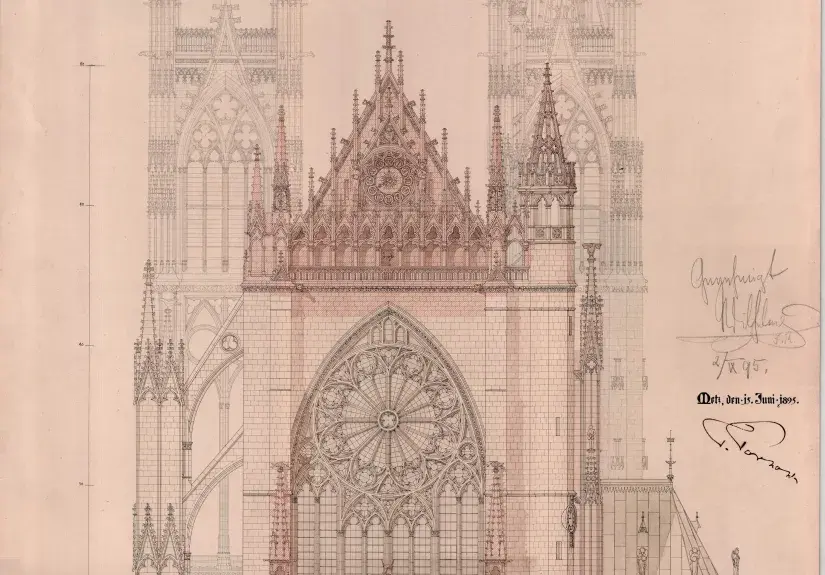
Soutenance de thèse / Raphaël Helfenstein / La restauration de la cathédrale de Metz par Paul Tornow, 1874-1906. Chroniques d’un chantier impérial en Moselle
L’ED 441 a le plaisir de vous inviter à la soutenance de thèse de Rafael-Florian Helfenstein, préparée sous la direction de Philippe Plagnieux :
La restauration de la cathédrale de Metz par Paul Tornow, 1874-1906.
Chroniques d’un chantier impérial en Moselle
20 décembre 2023, 14h00
Université Paris 1 Panthéon-Sorbonne, 12, place du Panthéon, 75005 Paris
Salle 216
Jury
Philippe PLAGNIEUX, Professeur des universités, HiCSA, Paris 1 Panthéon-Sorbonne, directeur de thèse
Anne-Marie CHÂTELET, Professeur émérite, ARCHE, UR3400, Université de Strasbourg, rapporteur
Christiane WEBER, Professor-Doktoringenieur, Institut für Architekturgeschichte, Universität Stuttgart, rapporteur
Christian FREIGANG, Universitätsprofessor, Kunsthistorisches Institut, Freie Universität Berlin, examinateur
Jean-Michel LENIAUD, Directeur d’études honoraire, École Pratique des Hautes Études, examinateur
Résumé
À l’image de la Moselle, la cathédrale Saint-Étienne de Metz cristallise une histoire mouvementée. Construite sur près de trois siècles, elle subit d’importantes modifications au milieu du XVIIIe siècle : son environnement d’origine disparaît au profit d’un aménagement urbain parfaitement ordonné et dessiné par Jacques-François Blondel. Le XIXe siècle marque tout aussi profondément l’édifice : les Français déposent progressivement les ajouts classiques et isolent le monument de son contexte urbain. En 1871, la cathédrale intègre le nouvel Empire allemand. Elle connaît alors une profonde restructuration rendue possible par des moyens financiers hors norme et des ambitions politiques nouvelles portées par Guillaume II.
Nommé Dombaumeister en 1874, l’architecte prussien Paul Tornow établit rapidement un grand projet pour Metz. En trente-deux années, il restaure la quasi-totalité de la cathédrale et dirige trois grandes séries de travaux qui modifient en profondeur l’édifice : reconstruction de la toiture, restauration du portail de la Vierge et création du portail principal. En dépit de ses longues années au service du monument, l’architecte ne verra pas aboutir ses projets de flèches sur la tour du Chapitre et à la croisée du transept, correspondant à une vision idéalisée de la cathédrale médiévale.
Cette recherche met en exergue l’ensemble des travaux, réalisés ou non, de Paul Tornow sur la cathédrale. Dans un contexte géopolitique tendu, le prussien n’a pas cherché à germaniser la cathédrale, mais à la rapprocher le plus possible des grands modèles français du XIIIe siècle.
The restoration works of Metz cathedral by Paul Tornow, 1874-1906
Chronicles of an imperial restoration project in Moselle
Metz St-Stephen cathedral concentrates in every respect the aspects of the eventful history of Moselle. Built over nearly three centuries, the cathedral undergoes major alterations in the middle of the 18th century : its original surroundings disappear in favor of an urban development perfectly arranged and designed by Jacques-François Blondel. The 19th century imprints a deep mark on the monument: the French gradually remove the classical style additions and isolate the monument from its urban context. In 1871, the cathedral is integrated to the German Empire. The building goes through a profound restructuration own to tremendous financial means and William II of Prussia’s new political ambitions.
Appointed as Dombaumeister in 1874, the Prussian architect Paul Tornow promptly establishes a huge project for Metz. In thirty-two years, he completes the restoration of almost the whole building and manages three major works which will alter it deeply : reconstruction of the roof, restoration of the gate of the Virgin Mary and the creation of the main entrance. In spite of his dedication to the monument for many years, the architect will not be able to see his projects of spires on top of the Chapter Tower and over the crossing according to his idealized view of the medieval cathedral.
This research highlights the achievement of the works, completed or not, by Paul Tornow on Metz cathedral. Amidst a tense geopolitical context, the Prussian architect did not attempt to germanize the cathedral but rather establish a closer connection with the leading examples of French medieval models of the 13th century.
Mots-clés
Metz, cathédrale, Annexion, restauration, patrimoine, théorie